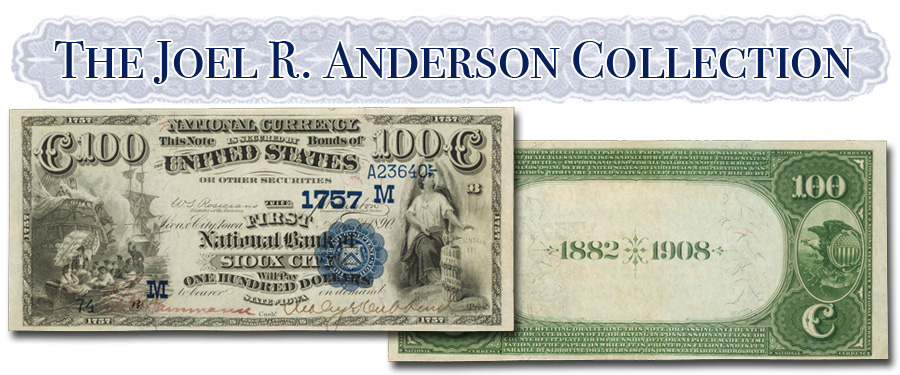
Momentum builds for our forthcoming sale of the Joel R. Anderson Collection of large-size paper money types. Part 1 will cross the block at the Whitman Coin & Collectibles Expo in Baltimore next month, always one of the top shows of the year. The notes will be showcased in a special catalog as well as on the Internet.
By definition, the collection includes paper money from issues that are readily available, such as small denominations from the late 19th and early 20th centuries, to the rarest of the rare—often unique or nearly so and always among the finest known grade of the type.
This week’s showcase note is a $100 National from the First National Bank of Sioux City, Iowa. As you may know, National Bank Notes originated with an act of Congress in 1863 that provided for banks to be established under federal charter and to issue federal notes. Each bank was required to put up 90% of its capital in Treasury bonds that were held in Washington. If a bank failed, as some did, the notes would still be redeemable at face value. Denominations included $1, $2, $5, $10, $20, $50, $100, $500, and $1000. Only one $500 is in private hands, and there are no $1000 notes. That leaves as collectible the denominations from $1 to $100.
Varieties of the $100 include Original, Series of 1875, Series of 1882 Brown Back, Series of 1882 Value Back, Series of 1882 Date Back (as here), Series of 1902 Red Seal, 1902-1908 Date Back and Series of 1902 Plain Back. All are rare, with the final issue of 1902 being less so.
The rarity is compounded by the state in which a bank is located. A $100 note from New York is much more available than one from Iowa. Grade is another factor, and of those that survive, very few can match the condition of the offered Anderson note.
This is estimated to bring in the range of $15,000 to $25,000.
Very Choice Sioux City $100 Date Back
Sioux City, Iowa. $100 1882 Date Back. Fr. 566 (W-3560). The First NB. Charter #1757. PCGS Currency Very Choice New 64. This is a difficult $100 National Bank note type to acquire. Not only is it tough as a type note, the condition offered here makes it another "trophy note," particularly for the collector of Iowa National Bank notes.
These notes were beautifully designed with the vignette at left depicting Commodore Oliver Hazard Perry leaving his flagship, the Lawrence, during the Battle of Lake Erie in 1813. At right is a depiction of Liberty, seated by a fasces representing the Union, along with the message "Maintain It!" The largely open back design features the 1882-1908 date range which gives these notes their "Date Back" name. This boldly printed and crisp note displays deep blue overprints and neatly penned bank officers’ signatures. The paper is well margined with deep embossing evident from the back of the note.
PCGS Population 1; 0 finer.
From Lyn Knight February 1996, lot 757.
About the Bank
The First National Bank of Sioux City was organized on December 28, 1870, with an authorized capital of $100,000. In 1874 the cashier was Thomas J. Stone and Asahel W. Hubbard was the president. Banker’s Magazine and other journals told of changes, an example being H.B. Rice elected president in early 1874.
The bank ran into difficulty with the Panic of 1893 and the economy in subsequent years. The bank shut its doors on November 19, 1896, and a receiver was appointed on January 1, 1897. Marvelously, the bank was restored to solvency by March 16, 1897. In the next four years it assumed the assets of four other banks and prospered. There was trouble in paradise during the late 1920s, and the bank was placed in receivership on December 8, 1930. The Federal Reserve gave as the reason a combination of local depression and incompetent management.





